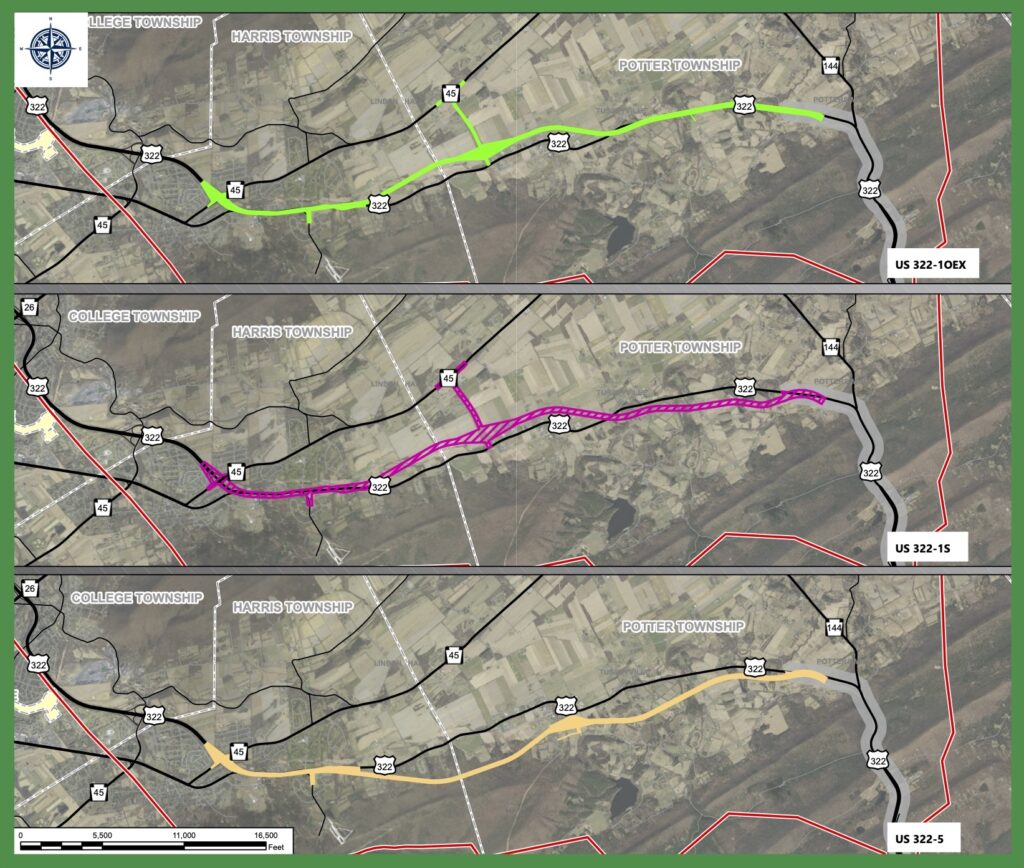A potential connection to Route 45 will no longer be part of planning for the State College Area Connector project, the Pennsylvania Department of Transportation announced on Friday.
The SCAC project will instead focus solely on the transportation needs of the Route 322 corridor.
“In listening to the feedback of our stakeholders, we’ve concluded that this is a prudent approach that follows through with one of the recommendations of the PEL Study and puts us on a path toward identifying a preferred alternative for the SCAC project,” PennDOT District 2 Executive Tom Prestash said in a news release.
The potential connector between Route 45 and U.S. 322 has raised worries about safety issues, pollution, damage to residential areas and Route 45 being ill-equipped to handle increased traffic.
PennDOT is allocating up to $3 million to study and address safety concerns on Route 45 in Harris and Potter townships identified during the SCAC Planning and Environmental Linkages (PEL) study, the department said on Friday. The study will be conducted separately from the SCAC project.
The initial study will focus on the section of Route 45 between Boal Avenue and the area slightly east of Old Fort. After analyzing existing conditions, it “will identify potential safety, operational and geometric upgrades,” according to PennDOT. The department plans to solicit public input and will provide a timeframe for the process during the early stages of the study
The final SCAC project PEL study report issued by PennDOT in August identified three build alternatives that will advance to the next phase of the process to improve the connection from the Seven Mountains area of Route 322 into the State College area and Interstates 99 and 80.
Each of the three options — US 322-1OEX, US 322-1S and US 322-5 — would connect U.S. 322 at the Mt. Nittany Expressway in Boalsburg and US 322 at Potters Mills Gap, where a four-lane section of highway was completed in 2021. The link would essentially complete a four-lane highway from Harrisburg to State College and beyond.
Both US 322-1OEX and US 322-1S would have had an interchange with a connector road between Route 45 and U.S. 322. All three would have service roads connecting to the local road network and would connect to the newly constructed U.S. 322/PA 144 interchange at Potters Mills Gap.
Each build alternative is about 8 miles long and is projected to divert nearly 53% of the total traffic and 73% of truck traffic from the local road network. Estimated costs range from $432 million and $517 million.
Harris Township supervisors and property owners in the proposed corridor have raised concerns about the potential alignments, stating that homes and longtime family farms may be lost, property values damaged and the rural character of the area forever altered.
PennDOT expects to hold a public meeting this summer to present the refinement to the build alternatives from the PEL study.

Possible alternatives in the Route 144 corridor routes that would have gone over Centre Hall Mountain, as well as upgrading the existing Route 322 in the study area, were eliminated earlier in the PEL study process.
PennDOT conducted the PEL study with the Federal Highway Administration to evaluate existing and projected transportation needs within a 70-square-mile area in the U.S. Route 322, state Route 45 and state route 144 corridor. Traffic volumes are expected to increase by more than 30% over 30 years, and the existing road network and configurations cause safety concerns and lack continuity, according to the 124-page study.
Following completion of the PEL study, the SCAC project has moved into the National Environmental Policy Act (NEPA) process and preliminary engineering, which represent the second of five phases for advancing a transportation project. NEPA mandates that agencies “consider the potential environmental consequences of their proposals, document the analysis and make this information available to the public for comment prior to implementation,” according to the Federal Highway Administration.
It will be followed final engineering design, right-of-way acquisition and construction. PennDOT has not yet identified any properties for acquisition, according to the SCAC website.
After being shelved for more than 15 years, Gov. Tom Wolf committed to funding the project in 2019. Construction is not expected to begin until 2028 and will take about five years to complete.



